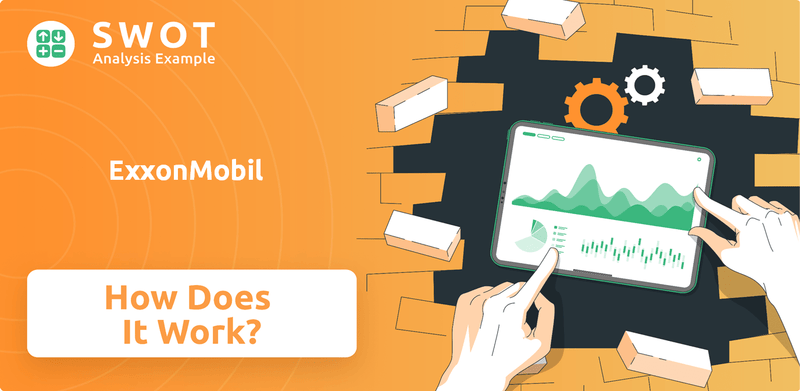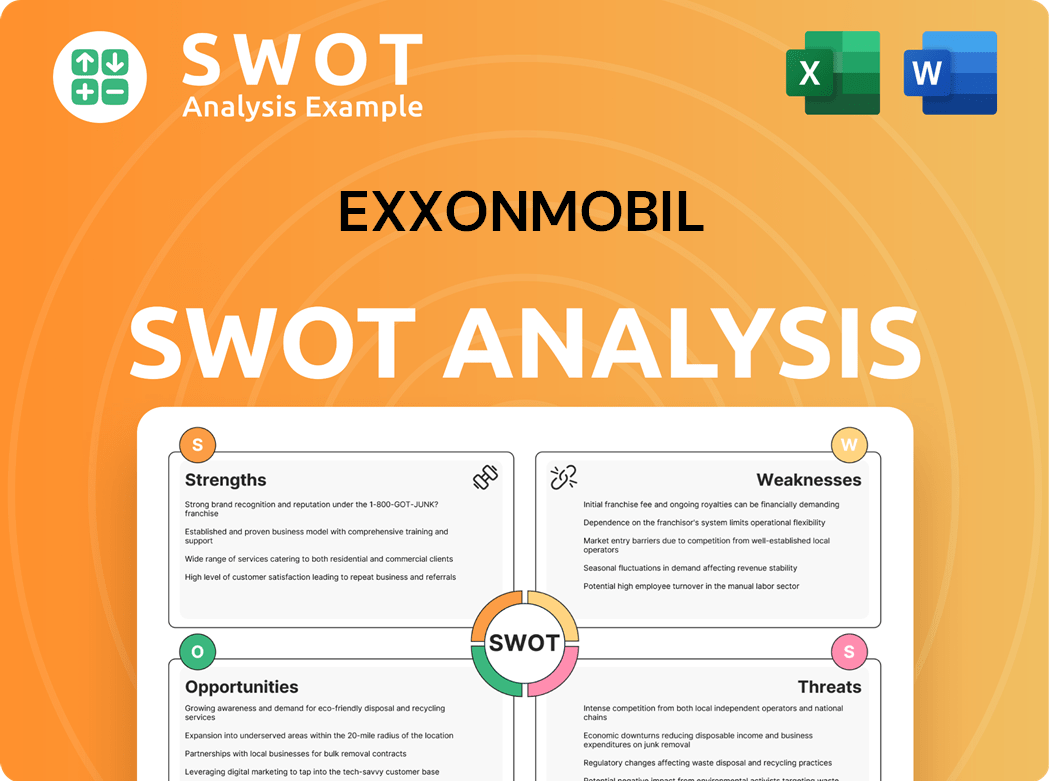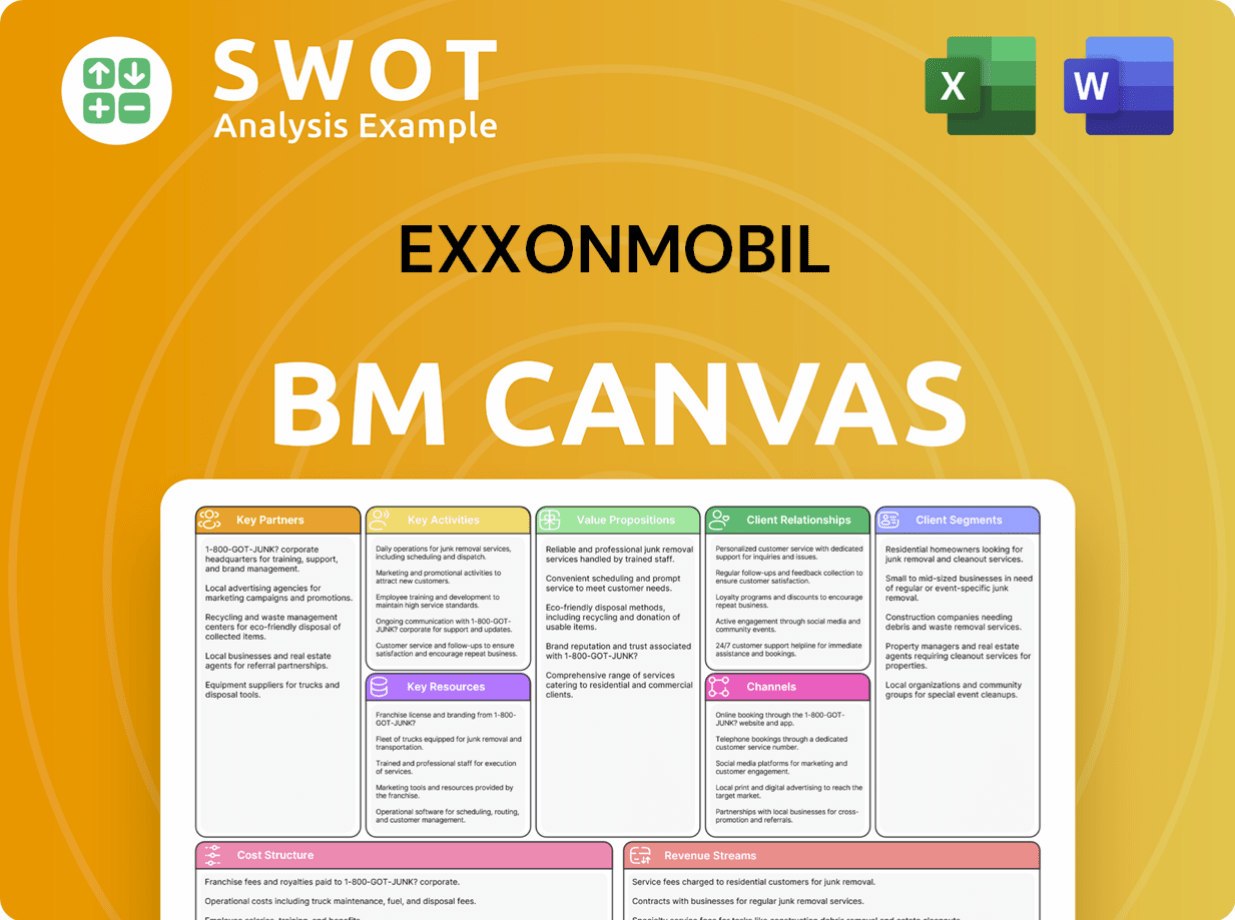ExxonMobil Bundle
How Does ExxonMobil Thrive in the Energy Sector?
ExxonMobil, a titan in the ExxonMobil SWOT Analysis, isn't just an oil and gas company; it's a global powerhouse shaping the energy landscape. With a market capitalization exceeding $462 billion as of June 2025, understanding its

This exploration will dissect ExxonMobil's intricate workings, from
What Are the Key Operations Driving ExxonMobil’s Success?
ExxonMobil, a major player in the energy sector, operates under a vertically integrated business model. This structure allows the company to manage processes from exploration and production to distribution. This integration enhances efficiency, maintains quality control, and helps with cost-effectiveness across its operations.
The company's core operations are divided into three main segments: Upstream, Product Solutions (integrating Downstream and Chemical operations), and Low Carbon Solutions. This structure supports the company's diverse activities within the petroleum industry, from finding and extracting resources to delivering products to consumers. To understand more about the company's strategic approach, you can explore the Target Market of ExxonMobil.
ExxonMobil's value proposition emphasizes a reliable energy supply, competitive pricing, customized solutions, and innovative strategies to improve operational efficiency while reducing environmental impacts. The company's focus on vertical integration, strong research and development, and technological advancements sets it apart from competitors. This translates into benefits for customers through a diverse portfolio of energy products and services.
The Upstream segment focuses on the exploration and production of crude oil and natural gas globally. ExxonMobil uses advanced technologies to maximize production and cut costs. The company plans to increase its Upstream production to 5.4 million oil-equivalent barrels per day by 2030, with over 60% from assets like the Permian Basin and Guyana.
Product Solutions integrates refining, marketing, and chemical operations. It produces and sells fuels, lubricants, and chemical products. This segment provides a wide range of petrochemicals used in various industries. ExxonMobil's supply chain ensures a reliable energy supply and competitive pricing for customers.
The Low Carbon Solutions business is focused on developing technologies to address energy needs while reducing emissions. This includes carbon capture and storage, hydrogen, and lithium. ExxonMobil aims to grow earnings contributions from its Low Carbon Solutions business by $2 billion in 2030 versus 2024.
ExxonMobil's value proposition is built on providing a reliable energy supply, competitive pricing, and customized solutions. The company's focus on vertical integration, R&D, and technological advancements differentiates it from competitors. These capabilities result in a diverse portfolio of energy products and services.
ExxonMobil's operations are characterized by significant investments in exploration and production, refining, and chemical manufacturing. The company's global presence and integrated business model allow it to manage risks and capitalize on market opportunities. Key aspects of ExxonMobil's operations include:
- Exploration and Production: Focus on finding and extracting oil and gas.
- Refining and Marketing: Processing crude oil into various products.
- Chemicals: Producing petrochemicals for industrial use.
- Low Carbon Solutions: Investing in technologies to reduce emissions.
ExxonMobil SWOT Analysis
- Complete SWOT Breakdown
- Fully Customizable
- Editable in Excel & Word
- Professional Formatting
- Investor-Ready Format

How Does ExxonMobil Make Money?
The revenue streams and monetization strategies of ExxonMobil are central to understanding its ExxonMobil business model. The oil and gas company generates revenue through a diverse range of activities, primarily focusing on the sale of crude oil, natural gas, refined petroleum products, and chemicals.
ExxonMobil operations are structured to maximize profitability across its various segments. The company employs a multifaceted approach to generate income, including direct sales, technology licensing, and strategic partnerships.
ExxonMobil's financial performance is a key indicator of its success in the energy sector. The company's ability to adapt and innovate is crucial for sustained growth in the dynamic petroleum industry.
The Upstream segment, focused on crude oil and natural gas production, is a major revenue driver. The Energy Products segment, which includes refining, is the primary source of sales. The Chemical Products segment also contributes significantly to overall revenue.
In 2024, Upstream earnings were $25.4 billion, increasing by $4.1 billion compared to 2023. This segment benefits greatly from high commodity prices.
The Energy Products segment saw a significant decline in earnings in 2024, falling by nearly 67% from $12.1 billion in 2023 to $4 billion. This decline was primarily due to weaker refining margins.
The Chemical Products segment's 2024 earnings were $2.6 billion, an increase of $940 million versus 2023, indicating growth in this area.
ExxonMobil utilizes direct sales of products, technology licensing, and joint ventures. The company is also investing in carbon capture and storage solutions, as well as hydrogen and lithium ventures.
ExxonMobil plans to invest up to $30 billion in lower emissions projects between 2025 and 2030. The company is also expanding its LNG portfolio, aiming for over 40 million tons per year in LNG sales by 2030, projecting $8 billion in annual cash flow.
ExxonMobil's total revenue for the twelve months ending March 31, 2025, was $349.632 billion, a 2.5% increase year-over-year. In 2024, the company made a revenue of $349.585 billion, a 1.45% increase from 2023. For more insights into the financial structure, consider reading about Owners & Shareholders of ExxonMobil.
ExxonMobil PESTLE Analysis
- Covers All 6 PESTLE Categories
- No Research Needed – Save Hours of Work
- Built by Experts, Trusted by Consultants
- Instant Download, Ready to Use
- 100% Editable, Fully Customizable

Which Strategic Decisions Have Shaped ExxonMobil’s Business Model?
The history of ExxonMobil, a major player in the oil and gas company sector, is marked by significant milestones and strategic decisions that have shaped its current operations. A key event was the 1999 merger of Exxon and Mobil, which aimed to create a more integrated and efficient business model. This consolidation was designed to enhance their competitive position in the energy sector.
In recent years, ExxonMobil has strategically divested assets to optimize its portfolio and redirect capital towards higher-margin ventures. These moves are part of an ongoing effort to streamline operations and enhance financial performance within the petroleum industry. These strategic adjustments reflect the company's commitment to adapting to market dynamics.
ExxonMobil faces operational and market challenges, including fluctuating oil and gas prices and increased global capacity. The company emphasizes disciplined capital allocation, focusing on high-return, low-cost-of-supply investments. ExxonMobil expects cash capital expenditures of $27-$29 billion in 2025 and $28-$33 billion annually from 2026-2030, focusing on advantaged long-term opportunities in new businesses and early-stage large projects in traditional businesses.
The 1999 merger of Exxon and Mobil was a pivotal event, creating a more integrated and competitive entity. This consolidation aimed to streamline the business model and enhance efficiency. The merger was a strategic move to strengthen their position in the energy sector, leading to significant operational changes.
Divestitures, such as the sale of French refining and chemical assets, allow ExxonMobil to focus on higher-margin ventures. These moves help reduce operational complexity and free up cash flow. The company maintains a significant European refining capacity of 1.1 million barrels per day.
ExxonMobil's brand strength, technological leadership, economies of scale, and vertically integrated business model provide a competitive edge. The company's brand fosters customer loyalty. Ongoing investments in research and development drive innovation in energy extraction and sustainability.
ExxonMobil is investing in low-carbon technologies like carbon capture and storage and hydrogen production. These initiatives demonstrate a commitment to reducing its environmental footprint and contributing to a lower-carbon future. The company is adapting to new trends and technology shifts.
ExxonMobil's competitive advantages include its strong brand, technological leadership, economies of scale, and vertically integrated business model. The company's focus on technology has led to breakthroughs in exploration and efficiency. The vertically integrated model allows control over the entire value chain, leading to cost efficiencies.
- Brand Strength: Widely recognized and trusted, fostering customer loyalty.
- Technological Leadership: Ongoing investments in R&D drive innovation.
- Economies of Scale: Large-scale operations lead to cost efficiencies.
- Vertical Integration: Controls the entire value chain from exploration to distribution.
ExxonMobil Business Model Canvas
- Complete 9-Block Business Model Canvas
- Effortlessly Communicate Your Business Strategy
- Investor-Ready BMC Format
- 100% Editable and Customizable
- Clear and Structured Layout

How Is ExxonMobil Positioning Itself for Continued Success?
ExxonMobil, a major player in the oil and gas company sector, holds a significant position in the global market. Its operations are extensive, and it continues to adapt to the changing energy landscape. The company's business model is built on a foundation of exploration, production, refining, and marketing of petroleum products.
Despite its strong market presence, ExxonMobil faces various risks, including volatile oil prices and increasing competition from renewable energy sources. The company's future outlook involves strategic investments in both traditional and new energy ventures, aiming to enhance its financial performance and adapt to evolving market demands.
In 2023, ExxonMobil held a 3.23% share of the global oil and gas market. As of Q1 2025, it held a 23.04% market share within the Oil & Gas Integrated Operations Industry and a 14.82% market share within the Energy Sector. Its market capitalization was roughly $462.07 billion USD in June 2025, positioning it as the 20th most valuable company globally.
ExxonMobil faces risks from fluctuating oil and gas prices. Additionally, potential damage to its reputation from incidents and changing consumer views on fossil fuels are threats. Increased global capacity has pressured refining margins, leading to a 67% decline in earnings from the Energy Products sector in 2024 compared to 2023.
ExxonMobil plans to increase Upstream production to 5.4 million oil-equivalent barrels per day by 2030. It plans to invest up to $30 billion in lower emissions opportunities between 2025 and 2030. The company anticipates investing $27-$29 billion in cash capital expenditures in 2025 and $28-$33 billion annually from 2026-2030. For more details, see the Growth Strategy of ExxonMobil.
ExxonMobil aims to deliver incremental growth potential of $20 billion in earnings and $30 billion in cash flow. The company plans for $20 billion in share repurchases annually in 2025 and 2026. Its commitment to returning capital to shareholders is evident in its 42 consecutive years of increasing annual dividends.
ExxonMobil Porter's Five Forces Analysis
- Covers All 5 Competitive Forces in Detail
- Structured for Consultants, Students, and Founders
- 100% Editable in Microsoft Word & Excel
- Instant Digital Download – Use Immediately
- Compatible with Mac & PC – Fully Unlocked

Related Blogs
- What are Mission Vision & Core Values of ExxonMobil Company?
- What is Competitive Landscape of ExxonMobil Company?
- What is Growth Strategy and Future Prospects of ExxonMobil Company?
- What is Sales and Marketing Strategy of ExxonMobil Company?
- What is Brief History of ExxonMobil Company?
- Who Owns ExxonMobil Company?
- What is Customer Demographics and Target Market of ExxonMobil Company?
Disclaimer
All information, articles, and product details provided on this website are for general informational and educational purposes only. We do not claim any ownership over, nor do we intend to infringe upon, any trademarks, copyrights, logos, brand names, or other intellectual property mentioned or depicted on this site. Such intellectual property remains the property of its respective owners, and any references here are made solely for identification or informational purposes, without implying any affiliation, endorsement, or partnership.
We make no representations or warranties, express or implied, regarding the accuracy, completeness, or suitability of any content or products presented. Nothing on this website should be construed as legal, tax, investment, financial, medical, or other professional advice. In addition, no part of this site—including articles or product references—constitutes a solicitation, recommendation, endorsement, advertisement, or offer to buy or sell any securities, franchises, or other financial instruments, particularly in jurisdictions where such activity would be unlawful.
All content is of a general nature and may not address the specific circumstances of any individual or entity. It is not a substitute for professional advice or services. Any actions you take based on the information provided here are strictly at your own risk. You accept full responsibility for any decisions or outcomes arising from your use of this website and agree to release us from any liability in connection with your use of, or reliance upon, the content or products found herein.